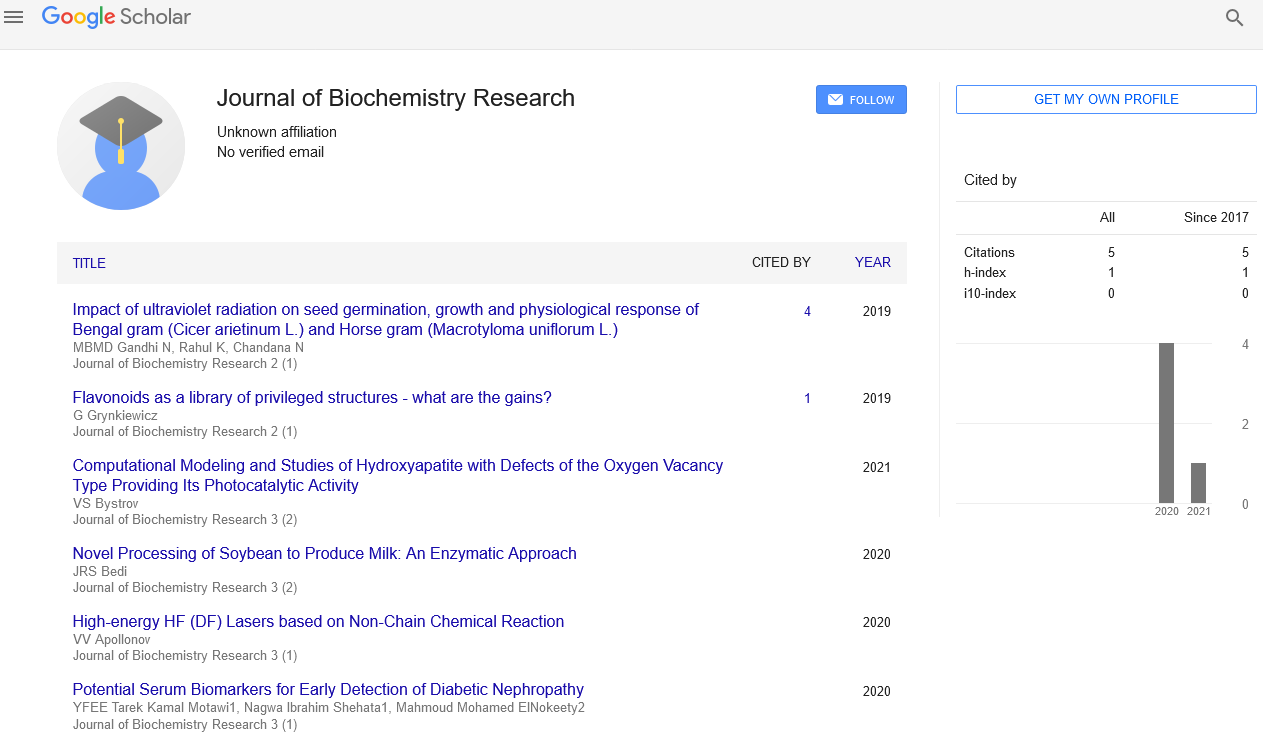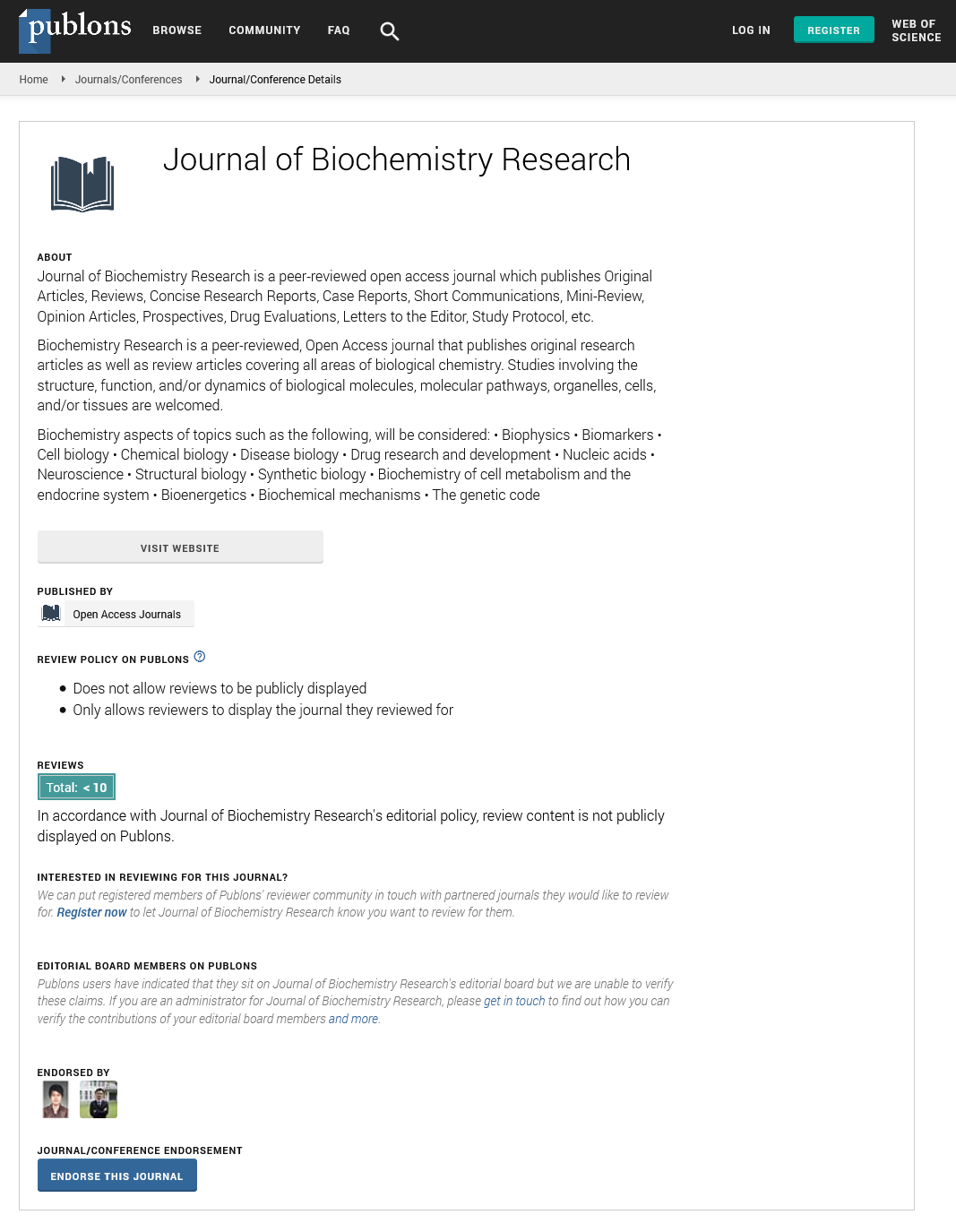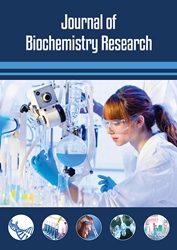Editorial - Journal of Biochemistry Research (2023) Volume 6, Issue 3
Exploring the Fascinating World Purification and Characterization of Biological Molecules
Kerry Du*
Department of biological Science and Biochemistry, University of Bhutan
- *Corresponding Author:
- Kerry Du
Department of biological Science and Biochemistry, University of Bhutan
E-mail: kerryd@gmail.co.edu
Abstract
This article explores the captivating realm of biological molecules, which are the fundamental units of life. Biological molecules encompass carbohydrates, lipids, proteins, and nucleic acids, each playing unique roles in the structure, function, and regulation of living organisms. Through a comprehensive examination of these molecules, their types, functions, and significance in various biological processes are elucidated. From energy storage and structural support to enzymatic reactions and genetic information transmission, the intricate interplay of these molecules governs the complex machinery of life. By unraveling the mysteries of biological molecules, we gain a deeper understanding of the fundamental principles that underlie living systems and pave the way for advances in numerous scientific disciplines. This article explores the fascinating world of biological molecules by providing an overview of the methods, materials, and techniques employed in their exploration. From isolation and purification to characterization and analysis, these methods enable researchers to unravel the structure, function, and interactions of proteins, nucleic acids, and carbohydrates. Understanding these methods is crucial for advancements in fields such as biochemistry, molecular biology, and biotechnology, ultimately leading to a deeper understanding of life at the molecular level.
Keywords
Biological molecules • Biomolecules • Carbohydrates • Lipids • Proteins • Nucleic acids • Energy storage • Structural support • Enzymatic reactions• Genetic information • Cell signaling
Introduction
In this exploration, we will delve into the captivating world of biological molecules, uncovering their structures, functions, and the extraordinary ways in which they contribute to the complexity and diversity of life [1]. We will witness the elegance of DNA, the blueprint of life, and its role in storing and transmitting genetic information. We will unravel the intricacies of proteins, the workhorses of the cell, responsible for carrying out essential functions and orchestrating biological processes [2]. We will marvel at the versatility of carbohydrates, the energy suppliers and building blocks of cells [3]. And we will discover the significance of lipids, the molecular architects of cell membranes and key players in vital biological processes [4]. As we embark on this journey, we will not only explore the fundamental aspects of these biological molecules but also understand how their structures relate to their functions [5]. We will examine the chemical properties that govern their behavior and the interactions that drive their biological roles. By doing so, we will gain a deeper appreciation of the complex interplay between structure and function in the intricate web of life. Furthermore, we will explore the applications of biological molecules beyond their roles in nature [6]. From the development of life-saving drugs to the engineering of novel materials, the knowledge gained from studying these molecules has revolutionized fields such as medicine, biotechnology, and materials science [7]. Understanding the inner workings of biological molecules has allowed us to unravel the mysteries of diseases, design targeted therapies, and create innovative solutions to global challenges. Characterization techniques enable researchers to investigate the properties of biological molecules in detail. Spectroscopy methods, such as UV-Vis, fluorescence, and infrared spectroscopy, provide information about the absorption, emission, and transmission of light by molecules, elucidating their structural and functional characteristics [8]. Mass spectrometry offers insights into the mass and composition of molecules, while NMR and X-ray crystallography reveal the three-dimensional structures of molecules, unraveling their intricate arrangements. The analysis of biological molecules further enhances our understanding of their functions and mechanisms [9]. Protein analysis techniques, such as Western blotting, enzyme assays, and protein-protein interaction studies, allow researchers to explore protein expression, activity, and interactions. Nucleic acid analysis methods, including PCR, DNA sequencing, and RNA interference, enable the study of genetic information and gene expression [10]. Carbohydrate analysis techniques shed light on the structure and function of complex carbohydrates, unveiling their roles in various biological processes.
Proteins
Proteins are large, complex molecules composed of amino acids, often referred to as the building blocks of life. They are involved in almost every aspect of cellular structure and function. Proteins can act as enzymes, catalysts that facilitate biochemical reactions, allowing them to occur at a faster rate. They also serve as structural components, providing support and stability to cells and tissues. Additionally, proteins play key roles in cell signaling, immune responses, transportation of molecules, and many other vital processes in living organisms.
Nucleic acids
Nucleic acids are the genetic information carriers in living organisms. The two primary types of nucleic acids are deoxyribonucleic acid (DNA) and ribonucleic acid (RNA). DNA stores the hereditary information, encoding the instructions necessary for the development, growth, and functioning of all living organisms. RNA, on the other hand, serves as a messenger that transmits the genetic information from DNA to guide the synthesis of proteins. Nucleic acids play a fundamental role in genetic inheritance, molecular evolution, and the regulation of gene expression.
Carbohydrates
Carbohydrates, often referred to as sugars or saccharides, are vital sources of energy for living organisms. They consist of carbon, hydrogen, and oxygen atoms and exist in various forms, including simple sugars (monosaccharides), double sugars (disaccharides), and complex sugars (polysaccharides). Carbohydrates serve as a primary fuel source, providing energy for cellular processes. They also play important roles in cell structure, cell signaling, and cellular adhesion. Examples of important carbohydrates include glucose, cellulose, and glycogen.
Lipids
Lipids are a diverse group of molecules that are hydrophobic (water-insoluble) in nature. They include fats, oils, phospholipids, and steroids. Lipids serve as a major component of cell membranes, providing a barrier between the cell and its surroundings. They act as energy storage molecules, insulation, and protection for organs. Lipids also participate in signaling pathways and serve as precursors for the synthesis of important molecules, such as hormones. Examples of lipids include triglycerides, phospholipids (constituting the cell membrane), and cholesterol.
Methods
Biological molecule isolation
Cell lysis is the process of rupturing a cell membrane to release its constituent cells. Differential centrifugation is the process of separating various components according to their densities. Fractionation is the further division of components according to their size, charge, or other characteristics.
Purification of biological molecules
Using solubility differences to distinguish between target molecules and impurities in precipitation. Dialysis is the process of removing ions or small molecules by diffusing them over a semipermeable membrane. Using an electric field, gel electrophoresis separates molecules according to their size and charge.
Characterization of biological molecules
Spectroscopy: Examining how molecules interact with various light wavelengths (such as UV-Vis, fluorescence, and infrared).
Mass spectrometry: which measures the massto- charge ratio of molecules to provide details about their composition and structure.
Nuclear magnetic resonance (NMR): Investigating how molecules interact with a magnetic field to learn about their structural makeup.
X-ray crystallography: the process of using X-ray diffraction patterns to create a threedimensional model of a molecule.
Conclusion
The study of biological molecules is a captivating endeavor that allows us to unravel the intricacies of life’s fundamental processes. In this article, we have explored the methods, materials, and techniques employed in the exploration of biological molecules, including their isolation, purification, characterization, and analysis. By employing these diverse approaches, researchers gain insights into the structure, function, and interactions of proteins, nucleic acids, and carbohydrates, advancing our understanding of life at the molecular level. The isolation of biological molecules involves various techniques such as cell lysis, centrifugation, fractionation, and chromatography. These methods enable the separation and collection of specific molecules from complex biological mixtures, paving the way for further study. Purification techniques are crucial for obtaining highly concentrated and pure samples. Precipitation, dialysis, gel electrophoresis, and ultrafiltration are employed to remove contaminants and concentrate the target molecules, ensuring accurate characterization and analysis.
References
- Kessler DA, Feiden KL. Faster evaluation of vital drugs. Sci. Am. 272, 48-54 (1995).
- Sertkaya A, Wong HH, Jessup A et al. Key cost drivers of pharmaceutical clinical trials in the United States. Clinical Trials. 13, 117-126 (2016).
- Satir P, Christensen ST. Structure and function of mammalian cilia. Histochem Cell Biol. 129, 687-693 (2008).
- Blair DF, Dutcher SK. Flagella in prokaryotes and lower eukaryotes. Curr Opin Genet Dev. 2, 756-767 (1992).
- Dora, Veronica Della. Infrasecular geographies: Making, unmaking and remaking sacred space. Prog Hum Geogr. 42, 44-71 (2018).
- Fonseca, Frederico Torres. Using ontologies for geographic information integration. Transactions in GIS.6,231-257 (2009).
- Bianconi, Piovesan, Allisonet et al. An estimation of the number of cells in the human body. Ann Hum Biol. 40,463-471 (2013).
- Azevedo FA, Carvalho LR, Grinberg LT, et al. Equal numbers of neuronal and nonneuronal cells make the human brain an isometrically scaled-up primate brain. J Comp Neurol.513, 532-541 (2009).
- Vukasinovic.Real Life impact of anesthesia strategy for mechanical thrombectomy on the delay, recanalization and outcome in acute ischemic stroke patients. J Neuroradiol. 95, 391-392 (2019).
- Salinet ASM. Do acute stroke patients develop hypocapnia? A systematic review and meta-analysis. J Neurol Sci. 15, 1005-1010 (2019).
Indexed at, Google Scholar, Crossref
Indexed at, Google Scholar, Crossref
Indexed at, Google Scholar, Crossref
Indexed at, Google Scholar, Crossref
Indexed at, Google Scholar, Crossref
Indexed at, Google Scholar, Crossref
Indexed at, Google Scholar, Crossref
Indexed at, Google Scholar, Crossref


